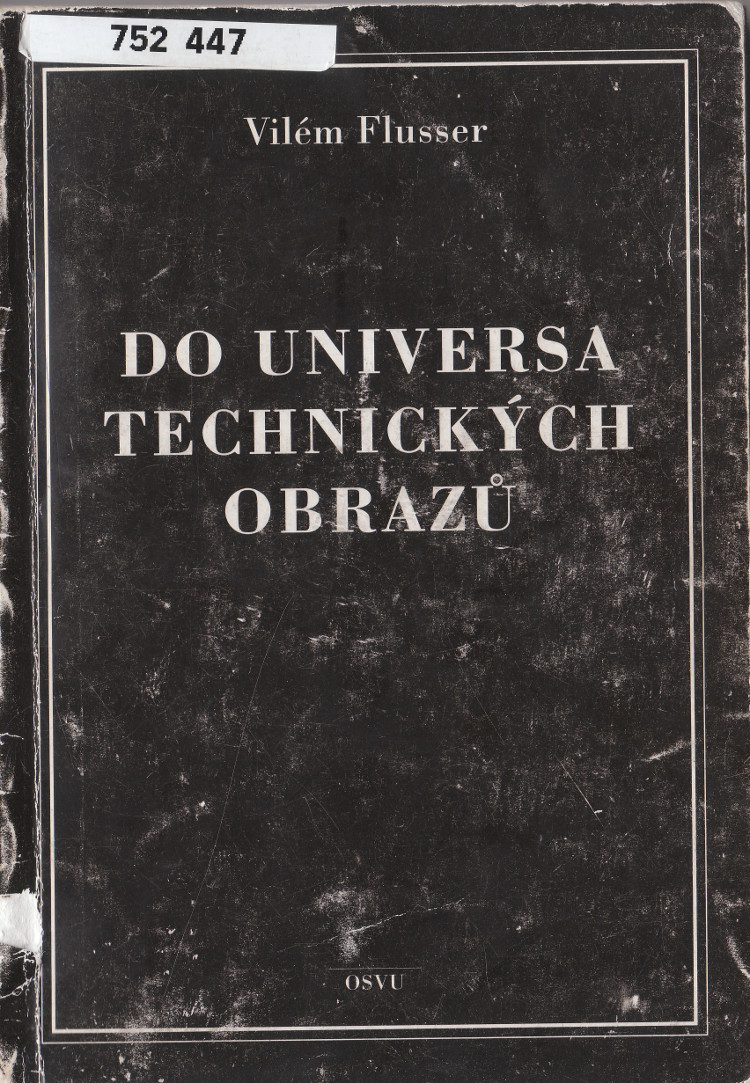Vilém Flusser: Into the Universe of Technical Images (1985–) [DE, HU, CZ, EN]
Filed under book | Tags: · communication technology, computing, cybernetics, database, entropy, image, media, media theory, philosophy, photography, postmodernism, technical image, technology, theory, virtual reality


Poised between hope and despair for a humanity facing an urgent communication crisis, this work by Vilém Flusser forecasts either the first truly human, infinitely creative society in history or a society of unbearable, oppressive sameness, locked in a pattern it cannot change. First published in German in 1985 and now available in English for the first time, Into the Universe of Technical Images outlines the history of communication technology as a process of increasing abstraction.
Flusser charts how communication evolved from direct interaction with the world to mediation through various technologies. The invention of writing marked one significant shift; the invention of photography marked another, heralding the current age of the technical image. The automation of the processing of technical images carries both promise and threat: the promise of freeing humans to play and invent and the threat for networks of automation to proceed independently of humans.
Originally published in German as Ins Universum der technischen Bilder, European Photography, 1985
Czech edition: Do universa technických obrazů
Translated by Jiří Fiala
Publisher OSVU, 2002
ISBN 8023875698
162 pages
English edition
Translated by Nancy Ann Roth
Introduction by Mark Poster
Publisher University of Minnesota Press, 2011
Volume 32 of Electronic Mediations
ISBN 0816670218, 9780816670215
224 pages
Review (Bob Hanke, International Journal of Communication)
Translator (EN)
Publisher (EN)
Ins Universum der technischen Bilder (German, 1985, added on 2016-8-4)
A technikai képek univerzuma felé (Hungarian, trans. József Maleczki, 2001; revised trans. Dalma Török, 2011; HTML, added on 2014-2-14)
Do universa technických obrazů (Czech, Jiří Fiala, 2002, no OCR, added on 2013-4-1)
Into the Universe of Technical Images (English, trans. Nancy Ann Roth, 2011, updated on 2012-7-17)
Luciano Floridi: Philosophy and Computing: An Introduction (1999)
Filed under book | Tags: · artificial intelligence, computing, hypertext, neural networks, philosophy, philosophy of technology, quantum computing, technology

“Philosophy and Computing explores each of the following areas of technology: the digital revolution; the computer; the Internet and the Web; CD-ROMs and Mulitmedia; databases, textbases, and hypertexts; Artificial Intelligence; the future of computing.
Luciano Floridi shows us how the relationship between philosophy and computing provokes a wide range of philosophical questions: is there a philosophy of information? What can be achieved by a classic computer? How can we define complexity? What are the limits of quantam computers? Is the Internet an intellectual space or a polluted environment? What is the paradox in the Strong Artificial Intlligence program?”
Publisher Routledge, 1999
ISBN 0415180252, 9780415180252
242 pages
PDF (updated on 2015-2-21)
Comment (0)IACAP: The Computational Turn: Past, Presents, Futures? conference proceedings (2011)
Filed under proceedings | Tags: · code, computational turn, computing, cyberwar, digital humanities, ethics, internet of things, philosophy, philosophy of computing, philosophy of technology, social computing, software, sousveillance, surveillance, technology, ubiquitous computing

In the West, philosophical attention to computation and computational devices is at least as old as Leibniz. But since the early 1940s, electronic computers have evolved from a few machines filling several rooms to widely diffused – indeed, ubiquitous – devices, ranging from networked desktops, laptops, smartphones and “the internet of things.” Along the way, initial philosophical attention – in particular, to the ethical and social implications of these devices (so Norbert Wiener, 1950) – became sufficiently broad and influential as to justify the phrase “the computational turn” by the 1980s. In part, the computational turn referred to the multiple ways in which the increasing availability and usability of computers allowed philosophers to explore a range of traditional philosophical interests – e.g., in logic, artificial intelligence, philosophical mathematics, ethics, political philosophy, epistemology, ontology, to name a few – in new ways, often shedding significant new light on traditional issues and arguments. Simultaneously, computer scientists, mathematicians, and others whose work focused on computation and computational devices often found their work to evoke (if not force) reflection and debate precisely on the philosophical assumptions and potential implications of their research. These two large streams of development – especially as calling for necessary interdisciplinary dialogues that crossed what were otherwise often hard disciplinary boundaries – inspired what became the first of the Computing and Philosophy (CAP) conferences in 1986 (devoted to Computer-Assisted Instruction in philosophy).
Since 1986, CAP conferences have grown in scope and range, to include a bewildering array of intersections between computation and philosophy as explored across a global range of cultures and traditions. In keeping with what has now become a significant tradition, IACAP‟11 will accept presentations across this array and range. At the same time, in order to recognize and celebrate the 25th anniversary of the CAP conferences, we specifically encourage submissions that include attention to the past, present(s), and possible future(s) of their foci as expressions of this computational turn.
International Conference of Computing and Philosophy (IACAP)
Organizing Chair: Charles Ess
Program Chair: Ruth Hagengruber
Aarhus University, 4-6 July 2011
336 pages

